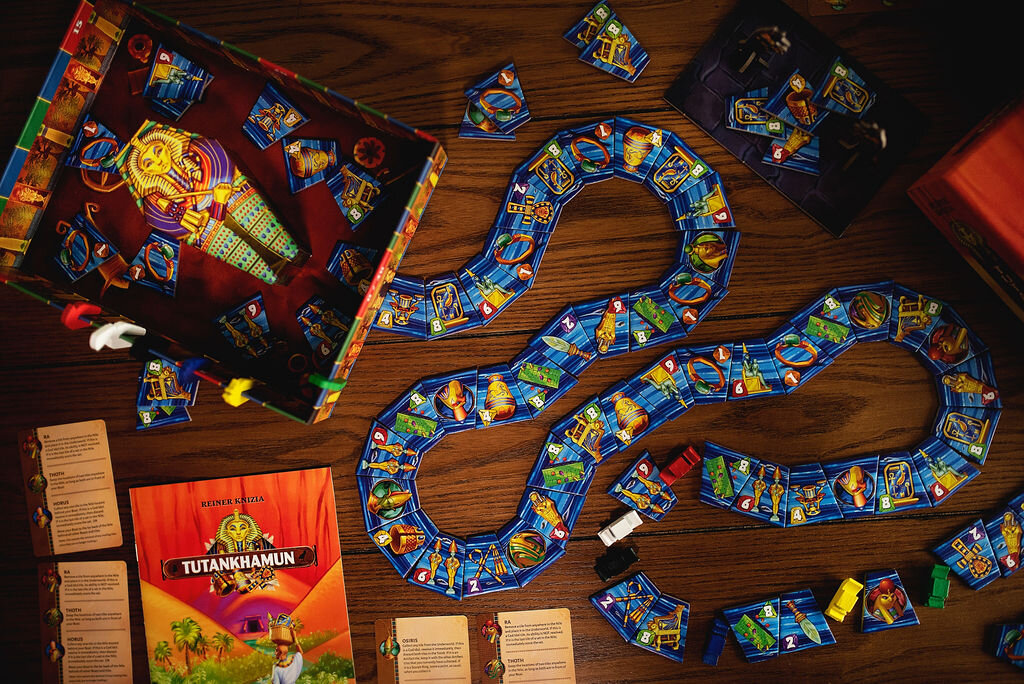Fill the Tomb to Pay Tribute to Tutankhamun

The Reiner Knizia set collection classic gets updated in this release from 25th Century Games.
Gameplay
Tutankhamun is a 2-6 player game where the goal is to collect the most of specific Artifact tiles to lose points until someone is left with zero.
Each player will take a color boat token and place their corresponding Canopic Jar scoring markers, placing it along the Spirit Track on the side of the box bottom which houses the scoring track. The 70 Artifact tiles, along with 10 God tiles, are shuffled face-down and then placed out into a long, winding Nile river. Players will take turns moving their boats along the river collecting the corresponding artifact titles. Players can move as far ahead as they wish, but they are only ever allowed to travel one tile directly behind them during a player’s move.
Artifact tiles include a number indicating not only the number of points someone will gain if they have the majority of them, but also how many exist along the river. Once players have collected all the tiles of that artifact type, points are tallied. The player with the majority receives the points shown, and the player with the second most will get half the total (for example, an artifact set that is worth 6 points will be rewarded to the player with the most, with 3 points going to the player with the second most of the set). Ties are broken by whoever’s boat is furthest back on the river. Sets are placed in the box (tomb) and are out of play after completion. Scarab Rings are a special type of artifact. Each is worth 1 point that is scored immediately, but collecting the most out of the 10 available along the river will net that player an additional 5 point reduction.
The river will also contain God tiles, each of which presents players with a special action, such as swapping tiles along the river, collecting tiles behind one’s boat, or trading a collected Scarab Ring tile for any tile along the river. Some God actions include the Underworld, a special board away from the Nile river. Certain artifacts and God tiles may be sent to the Underworld with a God action, while others may allow a player to collect a tile from the Underworld to add to their collection.
Once a player has reached zero on the Spirit Track, the next player finishes up their turn and the game is over. If multiple players have reached zero on the Spirit Track, the player whose boat is furthest back on the river is the winner.

Photo provided by the publisher
Review
The genius of most Knizia games lies in the simplicity of the mechanics and the cleverness of the play. Tutankhamun is an easy game to unpack and play, but the strategies of where to navigate one’s boat, which artifact sets to collect, and when to use a God action are always changing based on position, score, and timing.
The Underworld also presents its own uniqueness to the gameplay. Players may find themselves willingly exiling an artifact that could increase their collection to the Underworld to perhaps take it out of the game, only for another player to claim it later with a God action in a race to collect the most of that set. Players have to keep an eye on what is in the Underworld and leverage it strategically to their benefit or the detriment of their opponents.
The scoring system of first and second places getting points keeps all players engaged, and the game goes from potentially being a take-that game to a race to gain set majorities before others. It does little good to hate draft in Tutankhamun when the better benefit is maximizing your own sets for the maximum points, especially when most point totals are even numbers and therefore ties are ever-present.
There is little to criticize in this reimplementation of Tutankhamun. One could argue the scoring track being on the side of the box bottom can be unruly if you keep the insert within, but it’s fairly easy to remove from play to play (or entirely). Setting up the river can take a bit of time, but again, it becomes a mini-game unto itself as the trapezoidal tiles can be organized into any size and shape of river players need to fit the play space.
Pros: Simple mechanics, various strategies, gameplay keeps all players' attention
Cons: Score track on the box may bother some







